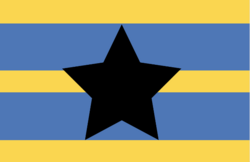Kathmantu
Kathmantu | |
|---|---|
|
Flag | |
Anthem: '' | |
| 300px | |
| Official languages | Ketu |
| Ethnic groups | Ketu (dominant), Antelanian |
| Religion | Ketu Hahnbu (official) |
| Demonym(s) | Kathma |
Kathmantu, is a large nation in western Volneria
Contents
- 1 History
- 1.1 Pre-unification
- 1.2 Unification of the Ketu (667)
- 1.3 Ketu-West Antelanian Treaty of 673
- 1.4 Sacking of Toruse
- 1.5 Kathmantu Conglomerate Empire (682)
- 1.6 Neutral zone
- 1.7 Migaza establishment
- 1.8 Padgali independence
- 1.9 Nguessu independence
- 1.10 Palerian and Torisinian independence
- 1.11 Zanzimar independence
- 1.12 The Great War
- 2 Geography
History
Kathmantu as a named entity has existed in some way shape or form since the first humans around the year 100. The region, known as the Kathma region, had been dominated by the Ketu people for hundreds of years, but its history is marked of ethnic diversity and tension.
Pre-unification
Before unification in 682, the border that outlined Kathmantu was maintained by the various tribes. The Harfala, Jzebkat, Komarlanian, Lushnu, Bezawitten, Padgali, and the North Antelanians all fought for influence over the border and what protected their tribes from destruction. Over time, the solidification of the eastern border became mutually recognized, but the fighting continued.
On the west coast, the city state of Toruse, a colony of the Torunian Empire was continually growing, influencing more and more Ketu people and spreading the Adasiatic language up the coast of the continent. The Antelanians adopted the language but were ethnically distinct from the Torunians.
Unification of the Ketu (667)
The 126 Ketu-speaking ethnic groups standardized their language and sought a future more consolidated and strategic than previous - seeing the destruction the ethnic tensions had been causing in the southern part of their territory.
Ketu-West Antelanian Treaty of 673
The Ketu formed an alliance with the West Antelanians to secure control over the continent and the war-ridden south and border regions.
Sacking of Toruse
The Ketu-West Antelanian alliance sacked the city state of Toruse in 682 and made their intentions clear to form the Kathmantu Conglomerate Empire with the Ketu people at the helm. The Ketu agreed to cede influence of the Torunians, Parkavid, and North Antelanians in the region to the West Antelanians.
Kathmantu Conglomerate Empire (682)
The empire was made up of many languages including Adasiatic, Ketu, Tali and Kathari. Harfal, Ontu, and Beza as minority languages. With Ketu as the dominant language, in modern day Kathmantu, the major minority language is Common Standard Ursha in its northern region.
The religions was predominantly Ketu Hahnbu and became Shakti Hahnbu. In some parts, Muhadism grew in the modern era but is predominantly isolated to the northern region.
Several conflicts with the Torunian Empire and their colony Torisinia, which bordered Kathmantu. Eventually they absorbed the colony until its independence as a nation in 0000.
Neutral zone
Migaza establishment
Padgali independence
Nguessu independence
Palerian and Torisinian independence
Zanzimar independence
The Great War
Geography
There are three main mountain ranges in modern day Kathmantu. The Nothern Kathmantu mountains are in the northwest of the country, the Utara mountains are in southern Kathmantu, and the Visala mountains which stretch from south to northeast Kathmantu.
